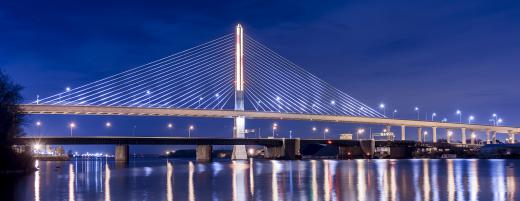A catenary is a natural curve caused when two posts support a free-moving object like a chain or cable. While this is often described through complex mathematical formulas, it has several applications in real-world architecture and design. When the shape is inverted, it forms a perfect standalone arch. The basic shape is also the underlying structure used in suspension bridges. In addition, a catenary cable is the name of a type of power line that delivers bulk power to transport systems.
The catenary curve is a shape generally well-known to most people. When two stationary or rigid posts hold a non-ridged material between them, gravity pulls the non-rigid material downwards and forms a curve. This curve, or inverted arch, is a catenary.

It is possible to find these arches nearly everywhere. They are common in any public place where a simple rope is used to stop people from passing. Clothes lines, power lines, even the cord between a handset and base on a corded phone make one of these shapes. Even natural shapes such as cobwebs, spider webs and some types of vines form catenaries.
Physicists, philosophers and mathematicians have studied the catenary shape for hundreds of years. These studies have yielded many interesting facts about the methods used to make the shape. In some cases, those methods may be applied to real-world architecture to create actual structures.
The catenary arch is an upside-down version of the curve and is one of architecture’s perfect shapes. If the arch has no additional weight or stress placed upon it, it produces no excess shear or pressure on its building materials. This means that the arch will stand on its own indefinitely with no outside maintenance or assistance.
A suspension bridge’s support cables generally start with a catenary shape, but move away from it as the bridge is built. The cables that hang between the towers on the bridge are tied to the bed of the structure. This creates an additional downward force on the cables, distorting the catenary design and turning the shape into a parabola. On the other hand, a simple rope bridge typically maintains the catenary shape naturally.
The power lines that deliver bulk power directly to transportation systems are called catenary lines in several parts of the world. Even though the line itself bears the name, it is named after the shape. These lines travel from a pole down to a power-delivery system, creating the iconic curve.
